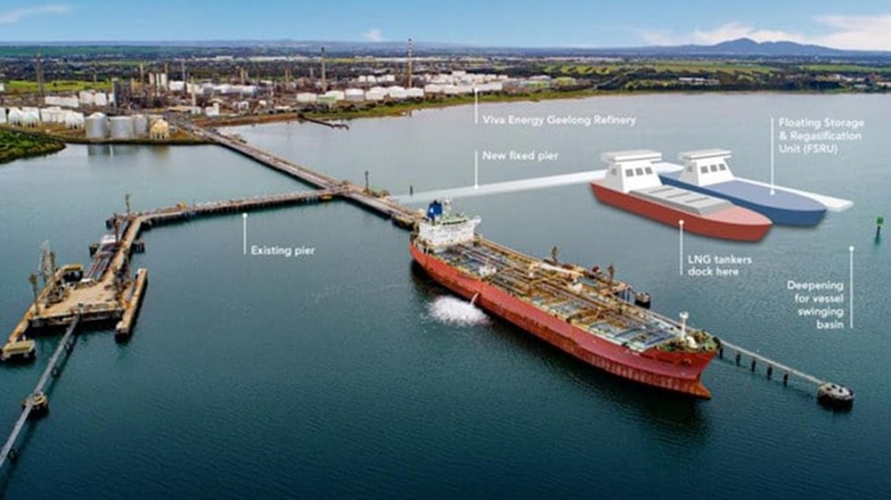Viva Energy chief executive Scott Wyatt at the company’s Geelong refinery. Picture: Aaron Francis
Viva Energy says its 1300-strong network of retail fuel outlets gives it a dominant position as the nation transitions towards mainstream electric vehicle usage, but the diversified energy firm says the shift will be at a measured pace.
In its pitch to investors on Wednesday, the company said its diversification across consumer convenience and fuels, commercial fuels, refining, and its proposed liquefied natural gas import terminal proposed for Geelong, provided it with both pillars for growth, and a path towards net zero.
It also forecast an uplift in earnings potential of about $50m per annum combined across all business units in coming years, with the development of the LNG terminal poised to bring on a new income stream and the company’s refining business bolstered by the imminent closure of a regional refinery.

Viva Energy is planning a floating LNG regasification unit at Geelong.
Refining’s future has also been underpinned by the introduction from July 1 this year of the federal Fuel Security Services Payment, which pays refiners during loss-making periods for petrol, diesel and jet fuel output.
Viva on Wednesday also announced a commitment to net zero scope 1 and 2 emissions across the non-refining parts of its business by 2030, while the gas terminal project, which is currently seeking approval, aims to achieve that target “for the life of the project, from the construction phase through all periods of operation’’.
Across the entire business including refining, the target was to hit this goal by 2050.
Viva said its retail performance had been “resilient” through the pandemic, and was poised for growth as the economy recovered.
The company was also talking up the earnings potential of transitioning to full ownership of the combined Liberty Convenience and Coles Express outlets it currently operates as partnerships, when those agreements expire in 2025 and 2029. Viva currently operates about 700 of its retail sites internally.
Viva’s business development and sustainability officer Lachlan Pfeiffer said the company was preparing its retail network for the transition to greater EV penetration, but said it forecast that they would only account for about 10 per cent of the Australian vehicle market by 2030.
“What Viva Energy brings is a superior network, a footprint with access to over 1300 retail sites across the country,’’ he said.
“We see an opportunity to extend the EV offer from public charging and into the commercial sector, servicing fleets and corporate customers, as they look to transition their businesses.
“So we expect to become increasingly active in this market in the near term as EVs become more widely adopted.’’
| WALL STREET JOURNAL03:36 What the electric vehicle boom means for the charging station industry |
While electric vehicles presented an obvious threat to the company’s fuel retailing business, Mr Pfeiffer said Viva’s forecasts, which aligned with the Federal Government’s, envisioned only about 1.7 million EVs on the road by 2030, with the reduction in fuel use by electric vehicles offset by economic and population growth.
“At that time we’re forecasting there will be about 30 per cent uptake of new vehicle sales being EVs at that time, which equates to about 10 per cent of the car pool being EVs as at 2030,’’ he said.
Mr Pfeiffer said hydrogen also presented a “strong opportunity” in the heavy vehicle market longer term.
“Australia is highly reliant on road trucking for its freight and commercial operations, and being able to provide a low emission product to this market is critical to the country’s long term net zero goals.’’
Chief executive Scott Wyatt said the vision for the “very long term, is to transform this business into a genuine convenience and mobility business’’.
“That is the strength, it’s a $9bn market growing at over 3 per cent per annum.
“Our models through the relationship we have with Coles is seeing our joint convenience business growing at more than 5 per cent, so outperforming.
“There’s not a lot of businesses around that demonstrate that sort of size and potential.’’
In the first half Viva
reported underlying net profit of $111.9m, with virtually all, or $108.6m, of
this coming from the retail, fuels and marketing side of the business.
Subscribe to our free mailing list and always be the first to receive the latest news and updates.
